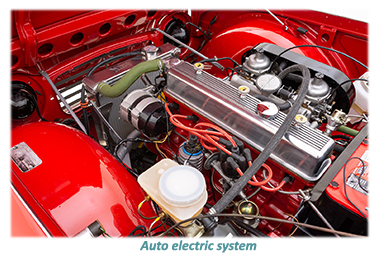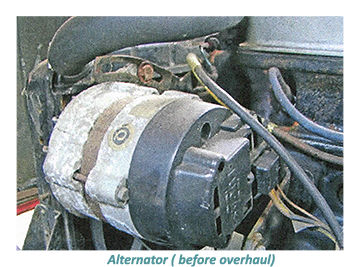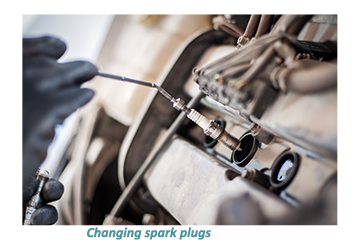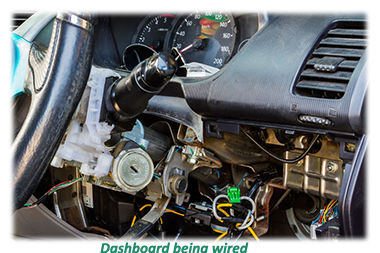 The almost non-invasive but essential function of any classic car is the auto electrics system, driven by a few silent and straightforward parts whose message is carried by hundreds of feet of wiring running through the length and breadth of the vehicle.
The almost non-invasive but essential function of any classic car is the auto electrics system, driven by a few silent and straightforward parts whose message is carried by hundreds of feet of wiring running through the length and breadth of the vehicle.
Most experienced restorers will tell you that when assessing a vehicle pre-purchase, there is little sense in investing too much time in looking over the electrics system, as little can be learned unless the car is a runner.
 TInstead, they assume that most components of the auto-electric system will need to be replaced, which is neither a complicated or expensive procedure. The minimum pre-purchase inspection worth spending time on is to examine the state of the wire harness under the hood, in the trunk, and under the dash.
TInstead, they assume that most components of the auto-electric system will need to be replaced, which is neither a complicated or expensive procedure. The minimum pre-purchase inspection worth spending time on is to examine the state of the wire harness under the hood, in the trunk, and under the dash.
Even if the seller frowns in disapproval, each electrical accessory should be tested to make sure they work correctly, taking in such secondary accessories as the indicators, gauges, dimmer switches, horns and centrally operated door locking systems in the unlikely event that there are any.
The majority of vehicles that have passed the thirty years mark and espcially those that are older will require some kind of work done on their wiring system.
The reason is that insulation gets stiff and brittle with time and eventually cracks and crumbles, leaving wires bare and prone to short-circuiting. Clean, neat wiring in excellent condition not only looks sharp, but it is safer, and the vehicle be more reliable.
Neglecting a vehicle's wiring system is a recipe for disaster, especially since replacing one is neither complicated nor particularly expensive.
![]()
The electrical system in any car can only spring into action once the key has inserted into the ignition switch and turned. The first task for any electrical system comes into play when the vehicle is stationary, when the driver wants to operate a reading light or even the car's radio (assuming one has been fitted.)
Before rewiring a car, you need a basic understanding of how automotive electrical systems work. Despite voltage supply being higher, if the wire is smaller in dimension, then the flow will be controlled by the wire and not the supply.
Anyone looking at the wiring circuit for 12-volt systems will be surprised to discover that the cables are smaller in diameter than those in a 6-volt system.
 Current is measured in amperes, or amps for short.
Current is measured in amperes, or amps for short.
 Voltage can be compared to water pressure. Irrespective of how high the voltage the same amount of current flow through a smaller diameter wire.
Voltage can be compared to water pressure. Irrespective of how high the voltage the same amount of current flow through a smaller diameter wire.
It is important to remember that any vehicle electrical system must be a loop or circuit. The circuit must be completed in the form of a light bulb or appliance. If the loop is not complete, a short circuit will occur, severe enough to destroy the entire wiring system. the battery and possibly even the entire vehicle( in extreme cases.)
Anyone attempting to rewire a car should have a basic understanding of how automotive electrical systems operate. The principle is a little different from conventional electronics in that electricity flows through wires, much like water flows through pipes.
![]()
A typical automotive circuit is the one used for lighting. Current flows through the wire from the positive pole of the battery to a light socket and bulb.
From there, it travels by way of the bulb's filament (which provides resistance), then back through the vehicle's sheet metal and frame, through the battery's ground strap and into the negative pole of the battery. The car metal acts as the return leg of the circuit.
That's why, when bare wires in your car touch metal, a short develops. And that's the reason why lights and accessories must be grounded to the car's frame or body. A bulb or motor that isn't grounded won't operate as its circuit is incomplete.
 A few inexpensive tools are all that are required to rewire most cars.
A few inexpensive tools are all that are required to rewire most cars.
If it can be found, the most invaluable will be the owner's manual for the vehicle being restored!
After that, a wire harness relating to the vehicle's year, a soldering iron, some lux and electronics solder. a wire stripper, some insulating tithing, as well as wire strippers and screwdrivers.
Having a mustimeter on hand will also be a big help.
Worthy of close scrutiny will be the vehicle's charging system consisting of the battery, a control box, and a generator, all of them linked to a sign on the dash.
The control box regulates the current flowing through the wiring system, reducing the flow to protect the electrical system from overflow.
Starter motors are used to turn over the engine from rest until it is spinning fast enough to operate.
![]()
Coming in two variations depending on the age of the vehicle, either Bendix type where the driving pinion or cog is drawn into mesh with the flywheel- or the pre-engaged type, in which the solenoid is fixed to the motor body and is used to push the starting pinion into the mesh, the Starter Motor, as its name suggests, is a crucial factor in the car's auto electrical system.
 The actual amount of time needed to burn our fuel/air mixture remains constant, so as engine speeds increase, the optimum time to deliver the spark will alter. To account for this, two methods of 'ignition advance' are commonly employed: centrifugal and vacuum advance.
The actual amount of time needed to burn our fuel/air mixture remains constant, so as engine speeds increase, the optimum time to deliver the spark will alter. To account for this, two methods of 'ignition advance' are commonly employed: centrifugal and vacuum advance.
A vehicle's lighting system provides illumination to allow you to see and be seen. After the starter motor, the headlamps are the biggest draw on the power supply, although unlike the starter, the headlights may be in use for many hours at a time.
 As with all elecric lighting, the lamps rely on the heating effect and will always be a compromise between brightness and longevity. The biggest problem with classic car lighting systems is usually system corrosion.
As with all elecric lighting, the lamps rely on the heating effect and will always be a compromise between brightness and longevity. The biggest problem with classic car lighting systems is usually system corrosion.
Getting a vehicle's auto electric system back into shape can represent a challenge, although far less severe and expensive than the other significant factors of car restoration.
The more that can be done in house, the better, as it does not require costly and intricate equipment or in-depth knowledge. Just a lot of patience and caution.



